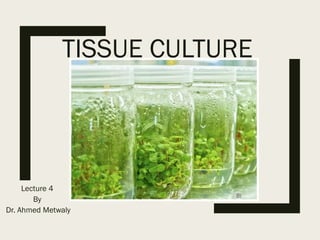
Tissue culture 4
- 1. Lecture 4 By Dr. Ahmed Metwaly TISSUE CULTURE
- 2. Objectives: Sterlization Applications of plant tissue culture ■ Breeding ■ Genetics ■ Model system ■ production of secondary metabolites
- 3. Sterilization methods ■ Medium, tools, vessels Autoclaving Filtering Ethylene oxide gas UV radiation Dry heat Microwave ■ plant materials Surface-sterilizing Alcohol Sodium /Calcium hypochlorite Mercuric chloride Hydrogen peroxide
- 4. Autoclaving ■ In order to eliminate bacterial and fungal contaminants, media must be submitted to heat and high pressure. Fungal spores may survive if only heat is used. Therefore, media is sterilized by heating to 121 ˚C at 103.5kPa for 15-20 min (15 lb in-2)
- 5. Dry Sterilization ■ Glassware can be sterilized in an oven by placing them at 200 ˚C for 1-4 hours. Be sure to cover glassware with aluminum foil to maintain aseptic conditions after removing the glassware from the oven. Avoid the use of any plastic caps, paper (i.e. labeling tape), or other flammable materials as they are fire hazards.
- 6. Filter Sterilization (for heat labile compounds) ■ Certain media components are susceptible to heat denaturation and therefore must be added to the media after autoclaving. To do so, you must filter the components using a 0.22μm pore size filter that is appropriate to the solvent used
- 8. Applications
- 9. Breeding ■ Micropropagation – using meristem and shoot culture to produce large numbers of identical individuals; Examples for micropropagation; dwarfing sweet cherry, Shade trees, Ornamental shrubs, Roses, Clematis, Lilacs, Saskatoon berries, Nutraceutical Plants, Rhododendron, Azalea, mustard, corn, soybeans, wheat, rice, cotton, tomato, potato, citrus, turf, legumes ■ crossing distantly related species and regeneration of the novel hybrid by protoplast fusion Protoplast fusion products are presently grown on approximately 42% of the fluecured tobacco acreage in Ontario, Canada. This represents a value of approx. US$199,000,000. ■ production of dihaploid plants from haploid cultures ■ Removal of viruses by propagation from meristematic tissues for ex; virus-free potatoes, produced by culture in vitro, gave higher yields than the normal field plants, with increases up to 150%. As only about 10% of viruses are transmitted through seeds
- 10. Genetics ■ Transformation, followed by either short-term testing of genetic constructs or regeneration of transgenic plants. For example; Flowering in aspen is generally observed after 8–20 years. One of homeotic genes (LFY) has been expressed in transgenic aspen and was able to produce flowers after 7 months of vegetative Growth (early flowering and faster growth) The transfer of herbicide resistant genes in tree species as the transgenic for herbicide resistance gene in Populus tree.
- 11. Model system ■ For study of plant cell genetics, physiology, biochemistry, and pathology
- 12. Production of secondary metabolites (Mechanisms) ■ Selection of high-producing strains ■ Precursor feeding ■ Elicitation
- 13. Selection of high-producing strains ■ Plant cell cultures produces a heterogeneous population of cells in which physiological characteristics are different. ■ The aim is to select cell lines yielding the higher levels of the desired product. ■ Cell suspension culture of Coptis japonica , which grew faster and produced a higher amount of alkaloids. Selected cell line increased growth about 6-fold in 3 weeks and the highest amount of alkaloid was produced 1.2 g/L of the medium and the strain was very stable, producing a high level of berberine even after 27 generations.
- 14. Precursor feeding ■ exogenous supply of a biosynthetic precursor to culture medium may also increase the yield of the desired product. ■ This approach is useful when the precursors are inexpensive. ■ The concept is based on the idea that any compound, which is an intermediate, in or at the beginning of a secondary metabolite biosynthetic route, stands a good chance of increasing the yield of the final product. ■ Feeding ferulic acid to cultures of Vanilla planifolia resulted in increase in vanillin accumulation
- 15. Elicitation ■ plants produce secondary metabolites in nature as a defense mechanism against attack by pathogens. ■ Elicitors are signals inducing the formation of secondary metabolites. ■ Biotic and abiotic elicitors which are classified on their origin are used to stimulate secondary metabolite formation in plant cell cultures.
- 16. Biotic elicitors. They include: ■ Enzymes, cell wall fragments of microorganisms, polysaccharides derived from microorganisms (chitin or glucans), and glycoproteins; ■ phytochemicals produced by plants in response to physical damage, fungi or bacteria attack, polysaccharides derived from plant cell walls (pectinor cellulose), fragments of pectin formed by action of microorganisms on plant cell wall. Abiotic elicitors are the substances of non-biological origin. The causes of the abiotic stress can be of chemical or physical nature; among them are: ■ Chemicals such as inorganic salts, heavy metals, some chemicals that disturb membrane integrity, ■ physical factors like mechanical wounding, ultraviolet irradiation, high salinity, high or low osmolarity, extreme temperature (freezing, thawing), high pressure
- 20. Production of secondary metabolites (Examples)
- 21. ■ Taxol: Taxol (plaxitaxol), a complex diterpene alkaloid These found in the bark of the Taxus tree, is one of the most promising anticancer agents known due to its unique mode of action on the microtubular cell system . ■ A century old tree yields an average of 3 kg of bark, corresponding to 300 mg of taxol, which is approximately a single dose in the course of a cancer treatment. ■ Taxus mairei calli were induced from needle and stem explants on B5 medium [Gamborg's et al., 1968] supplemented with 2 mg/l 2,4-D or NAA. Different cell lines were established using stem and needle-derived callus. One of the cell lines, after precursor feeding and 6 weeks of incubation, produced 200 mg taxol per liter cell suspension cultures.
- 23. Food additives from tissue culture sources
- 25. Summary: Applications of plant tissue culture ■ Breeding ■ Genetics ■ Model system ■ production of secondary metabolites
